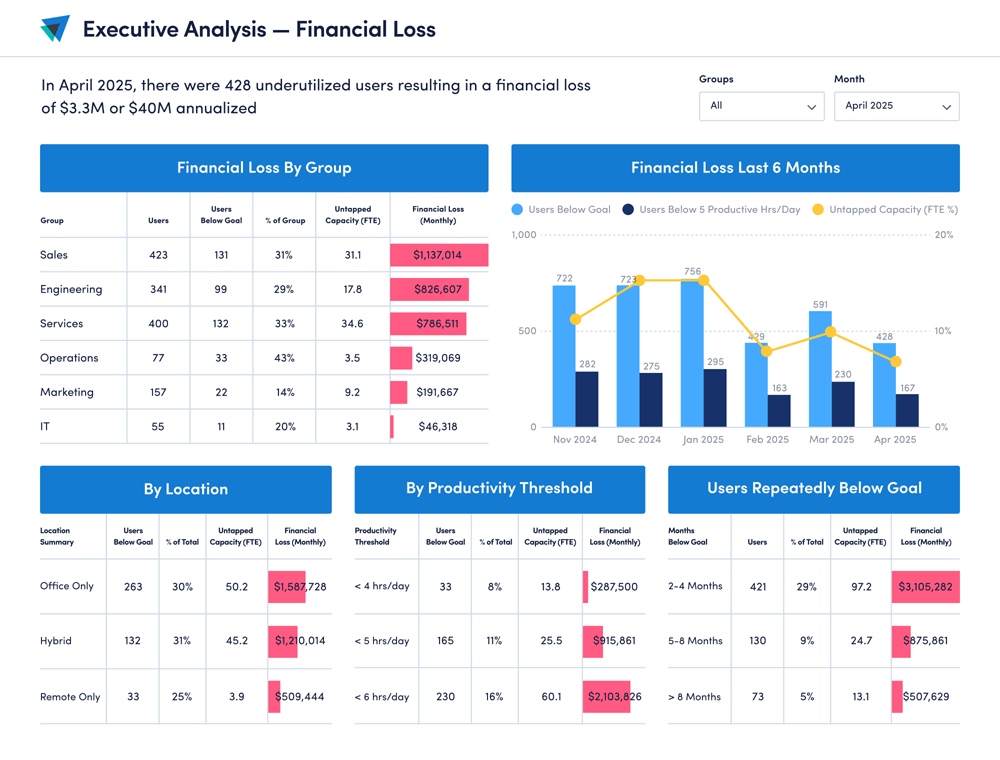Leaders can instantly access financial metrics, sales performance data and marketing ROI — yet workforce efficiency remains a blind spot. With labor representing 70% of business costs, this gap poses a significant risk for organizations lacking visibility into how workforce investments deliver value.
Organizations typically waste 20-30% of workforce capacity due to inefficiencies, costing millions in labor annually. For a mid-sized company with 1,000 employees and an average salary of $80,000, that’s $16-24 million in lost value each year.
Moving Beyond Traditional Productivity Metrics
Traditional workforce monitoring tools offer limited business value because employee activity tracking without financial context can’t answer key questions:
- Where is labor waste highest and what’s the dollar impact?
- Are we maximizing talent before adding headcount?
- Which activities drive results and where is focus misaligned?
- How much revenue potential is lost to idle or misaligned capacity?
- What’s the ROI of our performance improvement initiatives?
This disconnect between workforce data and business strategy limits leaders’ ability to make informed decisions and drive successful outcomes.
Translating Workforce Data into Financial Opportunity
ActivTrak’s new Financial Loss Analysis addresses this challenge by translating untapped workforce capacity into monetary impact. The dashboard surfaces underutilized FTEs across departments and maps them to salary costs, enabling executives to:
- Identify Hidden Capacity – find underutilized resources and quantify them in FTEs and dollars
- Target Cost-Saving Opportunities – filter by department, location or productivity threshold to pinpoint inefficiencies
- Measure Improvement Impact – track waste reduction and translate it into financial gains
- Make Informed Hiring Decisions – identify existing capacity before adding new staff

Early adopters have reported 15-20% reductions in unused capacity within 90 days and up to 10% in payroll savings.
Aligning Employee Activities with Business Outcomes
While Financial Loss Analysis quantifies workforce inefficiency at scale, Activity Alignment addresses its root cause: misaligned employee efforts. This enables managers to identify which activities drive business results and reduce time spent on low-value work.
One organization found top performers spent 75% of their time on high-value tasks while underperformers averaged just 48%. By shifting a portion of employee time from low- to high-value work, the company generated significant output gains without adding headcount.
Activity Alignment equips managers with:
- Performance Profiles – segment employees based on productivity and focus
- Activity Intelligence – highlight the tools and workflows that fuel success
- Coaching Frameworks – provide targeted guidance to drive measurable improvements
Real-World ROI: Metrics from ActivTrak Customers
Insight-led optimization delivers real financial impact. Customers using ActivTrak report:
- 10% reduction in annual payroll
- $33M savings from avoiding new hires
- 20% increase in output from existing teams
- 25% improvement in workforce utilization
- 122X ROI from combined savings and gains
These results elevate workforce optimization from a back-office initiative to a boardroom priority. With clear financial metrics, executives can integrate workforce planning into investor updates, performance reviews and long-term strategy.
Turning Workforce Data into Strategic Advantage
Today’s leaders face mounting pressure to drive performance, contain costs and stay agile — all without adding headcount. Workforce optimization is no longer just an HR concern; it’s a strategic lever for growth and profitability.
By turning workforce data into financial insight, leaders gain visibility into efficiency and output — fueling better resourcing, sharper alignment and stronger results.
For CFOs managing costs, COOs improving operations and CEOs driving long-term performance, workforce intelligence provides the missing link between workforce investments and business value.
Organizations that embrace workforce intelligence as a strategic capability turn inefficiencies into opportunity — and workforce strategy into a competitive advantage.
Learn more about how ActivTrak’s Financial Loss Analysis and Activity Alignment solutions can help your organization quantify and reclaim wasted workforce capacity. Contact us today for a personalized ROI assessment.





